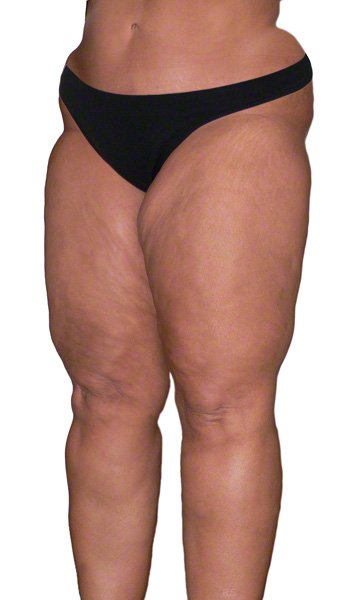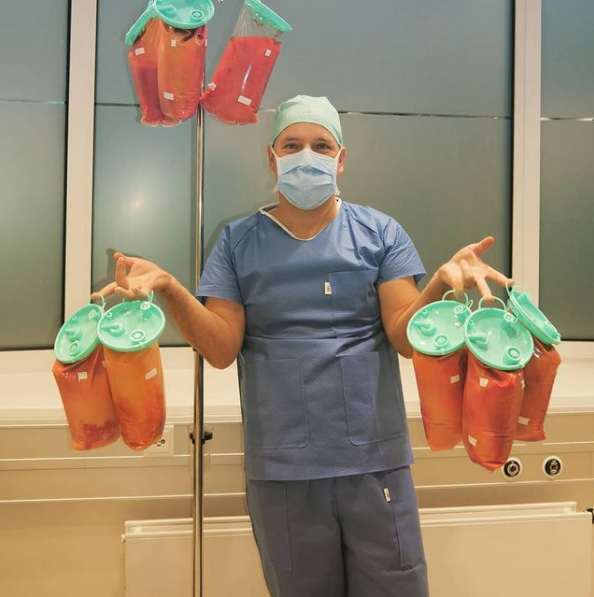On this page you can find out more about lipedema liposuction at the Yuveo Clinic in Düsseldorf.
It is the only method which makes it possible that a long-term treatment success can be achieved for a present fat distribution disorder.
This disease can affect overweight women as well as athletic and slim women.
Men are much less likely to develop the disease if they have specific hormonal disorders.
When non-surgical treatments have been exhausted and the symptoms of the mostly affected women cannot be reduced further, liposuction may be the right strategy.
Generally, larger amounts need to be liposuctioned, mainly in the legs, for this fatty tissue disorder, especially when it comes to advanced stages of lipedema.
However, the arms, hips and buttocks can also be affected.
Such liposuctions are only offered by a few specialists. Your plastic surgeons Dr Schumann and Dr Schumann-Averkiou have many years of experience with such procedures, and the entire Düsseldorf team is trained as well.
Our competent anaesthesia team at the Yuveo Clinic in Düsseldorf ensures gentle anaesthesia during lipedema surgery.
Inhalt
Yuveo Klinik
Characteristics of lipedema liposuction
It is the only method by which a long-term treatment success can be achieved in the case of an existing fat distribution disorder.
Liposuction - an efficient method
Rest and compression after surgery
Excess skin
Lipedema treatment
Lipedema treatment is managed by liposuction. This is a well-established surgery method.
However, before you decide to have this operation, we recommend that you exhaust the conservative treatment options.
You should also rule out other causes, circumferential increase, such as lymphedema or edema due to internal diseases, which show themselves through their specific symptoms.
Liposuction for a better quality of life
Liposuction reduces the amount of fatty tissue on the arms and legs (or hips and buttocks) affected by lipedema, sometimes drastically, which is accompanied by a significant reduction in physical as well as psychological discomfort.
Our patients benefit in particular from the reduced tendency to swell and the reduction in pain. This can significantly improve the patients’ quality of life.
Modern and gentle surgical method
In principle, the procedure for lipedema is carried out in the same way as described in the article liposuction.
A popular procedure is PAL (power-assisted liposuction), which uses micro-vibrations to ensure better tissue protection. In other words, because of the tissue protection, more fatty tissue of the lipoedema can be suctioned out than with the conventional technique.
Suction quantities vary greatly
The quantities that are suctioned depend on the complaints of the women and the stages of lipedema. While in the early stages, a few litres are sufficient, in advanced stages, so-called mega liposuction is performed with up to more than 10 litres of volume.
A fat distribution disorder that is mainly localised on the lower legs, thighs and hips.

FAQ: Lipedema treatment
What is lipedema?
This fatty tissue disease is a chronically progressive symmetrical and painful fat distribution disorder localised on the lower legs, thighs and hips.
This chronic progressive disease occurs predominantly in women and is familial.
What about causes and risk factors?
The causes of this disease have not yet been conclusively clarified.
However, there are indications that the hormonal situation of the patients plays a role. The oestrogen level (oestrogen = female sex hormone) is subject to fluctuations; for example, the picture is different during pregnancy than during the menopause or puberty.
In addition, there is sometimes a family history, which indicates that some patients have a hereditary predisposition.
In addition, severe psychological or physical stress can contribute to the development of lipoedema.
Certain vascular diseases in the subcutaneous tissue are also known causes.
Which symptoms of lipedema are known?
An exact professional differentiation from other similar clinical pictures is very important.
The symptoms occur symmetrically, predominantly on the legs, but also on the arms or hips.
Typical signs of the disease are aching legs and arms with a feeling of heaviness, especially during exertion, and a tendency to bruise.
The areas affected by the fat distribution disorder are also more sensitive to pain than others.
We will inform you about the different stages of the disease in the next point.
Which stages of lipedema can occur?
A classification of the stages is essentially made according to the externally visible features, for example on the thighs:
- In the beginning, fat accumulates on the outer thighs and buttocks. This is also known as “riding trousers”. The skin is still smooth at first, but the subcutaneous tissue thickens. Small ball-like structures can be felt on the knees and the inner thighs.
- At this stage, the riding breeches are much more pronounced. The skin surface is no longer smooth, but shows large dents and lumps. The subcutaneous tissue continues to thicken, but is not yet hardened.
- At this stage, there is a clear increase in the circumference of the legs. The heavily thickened subcutaneous tissue feels hard. Fat flaps form on the inner thighs, which can rub against each other. This can cause unpleasant chafing, which can also lead to inflammation (erysipelas).
Due to the weight gain, the joints are subjected to greater strain, which can also lead to leg deformities.
When does liposuction make sense?
Liposuction makes sense especially if the non-surgical treatment options do not lead to the desired success and the complaints cannot be permanently reduced.
Pain that can no longer be treated can also often be reduced by means of liposuction.
Furthermore, the aesthetic disproportion of the body proportions and the associated psychological suffering of the patients are often the reason for the decision to undergo liposuction.
Nevertheless, possible contraindications should be considered. These can include the following: serious secondary diseases, such as cardiac insufficiency, some cardiac arrhythmias, severe varicose vein disease, blood coagulation disorders and many more.
The estimated extent of the lipedema treatment should also be taken into account with regard to the resulting excess skin. When suctioning larger amounts (over 8-10 litres), you must reckon with the fact that, depending on the quality of the skin, shrinkage will only take place to a reduced extent. We would also like to point out that if there is a lot of excess skin on the thighs, a thigh lift may be necessary at a later date.
What is the aftercare like?
Aftercare depends on the severity of the lipoedema before the operation and on the extent of the operation.
Very important is decongestive treatment over several weeks to a few months, as there are often enormous amounts that are removed. These have a corresponding tendency to swell after the operation.
Rest and elevation of the legs are equally important.
The stitches at the puncture sites can usually be removed after 5 to 7 days in our clinic in Düsseldorf.
The final visible result after liposuction on the arms, legs, hips or buttocks can take several months.
The excess skin that can develop after extensive procedures is examined and we discuss with our patients whether additional skin tightening should be performed here.
How much time off do I need to take after liposuction?
We cannot give a precise answer to this, because it depends on the stage of the lipoedema and the extent of the liposuction. Individual factors also play a role.
The sensation of pain is very different, as is the stabilisation of the circulation during major procedures.
Furthermore, the treated areas and the structure of the tissue also play an important role. In the case of small procedures, it may be possible to return to work after only one week.
For large liposuctions of 10 litres or more due to an advanced stage of the disease, you will certainly have to plan for 2-3 weeks, depending on what activity you are doing.
How much does it cost?
The cost of liposuction for lipedema must be calculated similarly to normal liposuction. Most plastic surgeons in Germany make the price dependent on the amount and the localisation of the areas to be worked on.
Therefore, one has to calculate from lower costs for smaller liposuction procedures and up to higher costs for extreme findings. In addition, there are costs for the anaesthesia. Some plastic surgeons charge an additional price per night for an in-patient stay after liposuction.
When calculating the costs, it often plays a role in how many sessions the lipoedema operation is planned. In general, it can be assumed that many small sessions are significantly more expensive than one large operation.
Is it possible for the costs to be covered by the health insurance funds?
Although lipedema is a disease, health insurance companies do not usually cover the costs of liposuction. It is therefore a self-payment service.
The measures that do not require surgery range from activating the lymphatic system through special grip techniques to decongesting the affected body zones through pressure (compression treatment). They are covered by the health insurance funds, and thus lipedema is recognised as a disease.
If there is any uncertainty, please ask your statutory health insurance.
What is the difference between lipedema and lymphoedema?
Due to the fat distribution disorder, the lymphatic system that runs through our body can be restricted in its function.
The lymph cannot drain optimally and this can lead to fluid accumulation in the tissues.
So lipedema can actually cause lymphedema.
Lipedema and obesity - is there a connection?
One challenge is to distinguish lipedema from obesity and overweight, which are particularly due to a lack of exercise and a faulty diet.
What about nutrition, sport and counselling?
A vitamin-rich and balanced diet does not directly cure lipedema, but it helps you to feel more comfortable in your body and to basically stabilise your weight.
It is not surprising that you limit your movements because of the pain you experience.
But activity and exercise are helpful with lipedema. Especially sports with a low risk of injury and steady movements like swimming or walking are beneficial. You stay mobile and feel better overall.
Since the situation is psychologically stressful for many patients, it can be useful to use an accompanying therapy to talk about the associated worries.
How is conservative lipedema treatment carried out?
Conservative therapy without surgery can be briefly summarised as follows:
Diet: Take action against the excess weight! Increased food intake worsens the findings. Even after dieting, however, there is a disproportion in the body proportions of the women who are mostly affected.
Decongestion treatment:
manual lymph drainage
Compression treatment using compression bandages and compression garments (compression trousers, support garments) that exert pressure on the tissue.
If necessary, pneumatic decompression (trousers that can be inflated with air reduce water retention – oedema – in the legs through pressure).
Unfortunately, these treatments for lipoedema are often only of a temporary nature and have to be repeated at certain intervals.
This means that a reduction in the fatty tissue of the diseased tissue cannot be achieved.
The women’s complaints cannot be permanently controlled in this way. This only works within the framework of lipedema liposuction.
Checking the facts
- Surgeons: Dr. Schumann and Dr. Schumann-Averkiou
- Treatment duration:
About up to 3 hours - Anaesthesia:
local anaesthesia with twilight sleep, general anaesthesia - Hospital stay:
outpatient or inpatient - Aftercare:
Compression for several weeks to months, keep legs elevated, rest - Removal of stitches:
after about 5 to 7 days - Sport:
Time off for about 6 weeks - Costs: We will inform you about the costs.
Related topics
Liposuction
Lipomatosis, which includes lipedema, is a condition associated with a fat distribution disorder in which multiple (many) lipomas or a lipoma-like accumulation of fat tissue are found in certain regions.
Lipomas are isolated and asymmetrical fat growths.

